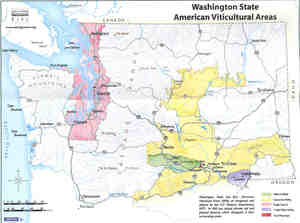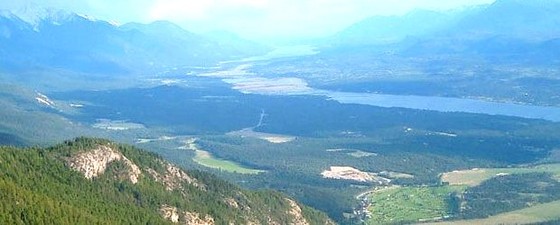First of a series about the American Viticultural Areas in Washington State. Above: a Columbia Valley landscape; below, Allen Shoup
It certainly made sense three decades ago, when Chateau Ste. Michelle's Bob Betz was doing his road show to promote the wines of Washington State, and regularly fielded questions (from well-meaning but clueless listeners) along the lines of "On what bank of the Potomac do you grow your grapes?"
 The solution, back in 1984, was to establish an American Viticultural Area for virtually all of Washington State's commercial vineyards, only a few thousand acres at the time and all east of the Cascades. An AVA would anoint them, as it were, with an official designation from the federal government, something akin to the French AOC (Appellation d'Origine Controlée) and the Italian DOC (Denominazione di Origine Controllata). The agency responsible for that certification, at the time known as the Bureau of Alcohol, Tobacco and Firearms (part of the Treasury Department, because it collected taxes on wine, today known as the TTF), wasn't equipped to determine quality, only to draw boundaries based on a petition from growers. The result was a gangly, 53-step map (sample: "Then east following the unnamed light-duty road for approximately 250 feet until it reaches the 2000′ contour line") incorporating 11 million acres. A giant blob (the yellow part of the map at the left) that covered nearly a third of the state.
The solution, back in 1984, was to establish an American Viticultural Area for virtually all of Washington State's commercial vineyards, only a few thousand acres at the time and all east of the Cascades. An AVA would anoint them, as it were, with an official designation from the federal government, something akin to the French AOC (Appellation d'Origine Controlée) and the Italian DOC (Denominazione di Origine Controllata). The agency responsible for that certification, at the time known as the Bureau of Alcohol, Tobacco and Firearms (part of the Treasury Department, because it collected taxes on wine, today known as the TTF), wasn't equipped to determine quality, only to draw boundaries based on a petition from growers. The result was a gangly, 53-step map (sample: "Then east following the unnamed light-duty road for approximately 250 feet until it reaches the 2000′ contour line") incorporating 11 million acres. A giant blob (the yellow part of the map at the left) that covered nearly a third of the state.
The proposed borders were drawn by Dr. Walter Clore of WSU (the father of the Washington wine industry) and Dr. Wade Wolfe (then in charge of vineyards for the state's largest winery, Chateau Ste. Michelle). Allen Shoup, left, who headed Ste. Michelle at the time, approved the plan and selected the name. With his marketing savvy, Shoup saw the need for a single, over-arching AVA to define the state, a rationale that still exists today. There's little of Burgundy's fussiness here over which side of an ancient Roman path produces grapes that smell like raspberries; that's a pretentious, angels-on-the-head-of-a-pin theological debate.
The AVA follows the meandering river itself, from Grand Coulee on the north, then along the flanks of the Cascades, and back across the high desert, embraces parts of three rivers - the Columbia, Snake and Yakima - as well as the Yakima Valley, Walla Walla Valley, Red Mountain, Wahluke Slope and Horse Heaven Hills AVAs. The one constant, as the AVA crosses these varies topographies, is the soil: volcanic, well-drained sandy loam. It's low in nutrients, which stresses the vines, and contributes to concentrated fruit flavor in the grapes (overwhelmingly riesling, cabernet sauvignon, merlot and chardonnay), almost all grown with manmade irrigation.
 "Any AVA this large may be characterized by the fact that it encompasses significant differences in rainfall, soils and climate,"explains Cole Danehower, author of Essential Wines and Wineries of the Pacific Northwest. "The most relevant thing is that the huge Columbia Valley AVA is defined as a warm-climate growing region." A high desert region, in other words, which is an important distinction, when entire countries (like New Zealand) define themselves as cool-climate regions.
"Any AVA this large may be characterized by the fact that it encompasses significant differences in rainfall, soils and climate,"explains Cole Danehower, author of Essential Wines and Wineries of the Pacific Northwest. "The most relevant thing is that the huge Columbia Valley AVA is defined as a warm-climate growing region." A high desert region, in other words, which is an important distinction, when entire countries (like New Zealand) define themselves as cool-climate regions.
If anyone were ever nuts enough to grow grapes in the scarified, unirrigated badlands between Moses Lake and Ritzville, that's not part of the AVA. The lush wheat fields of the Palouse aren't covered; neither is Spokane. Eleven million acres, potentially, but in fact, Washington's vineyards cover only 40,000 acres at this point (more than Napa, dwarfed by Bordeaux). Most are part of other AVAs as well; only 7,000 acres are exclusively Columbia Valley, but the Columbia Valley AVA remains the principal AVA in the state, if not the entire northwest.
Allen Shoup, on whose watch the state's original AVA was approved, says, "We wanted to penetrate the all-but-impenetrable membership of the world's finest wine regions by using a single name in all our marketing materials." Even today, most of the wine produced in Washington is sold (in Chicago, in China, in Japan) as "Columbia Valley." Even here in Washington State, how many people out there have even heard of Snipes Mountain, let alone have a clue about its terroir?
Note: My series on Washington AVAs appears regularly in Edible Seattle
.

Leave a comment